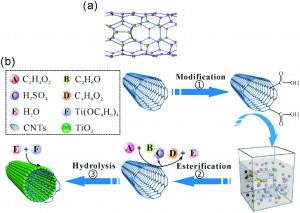Posted on behalf of Liana Allen, web writer for Dalton Transactions
Titanium dioxide (TiO2) is a material with many interesting and attractive characteristics; for example, it is low-cost, non-toxic and relatively chemically inert.1 Due to these features, TiO2 is frequently used in fields such as solar energy, sensors and environmental protection.2 The latter area exploits titanium dioxide’s ability to act as a photocatalyst – meaning it uses UV light (from solar radiation) to catalyse a chemical reaction – to decontaminate water containing organic pollutants.
Despite these favourable properties, use of titanium dioxide has disadvantages. The efficiency of TiO2 as a photocatalyst is fairly low – it can only use about 4% of the solar energy it receives. Moreover, recovery of TiO2 nanoparticles from water after decontamination is challenging. A commonly used strategy to overcome these issues is to incorporate the TiO2 into another functional material as a core-shell composite.3 One such functional material is carbon nanotubes (CNTs), which, in addition to aiding in removal of TiO2 from water, have been shown to enhance the efficiency of TiO2 as a photocatalyst.
In this paper the authors present an improved, facile preparation of the carbon nanotube–TiO2 composite. Previous syntheses had major drawbacks as they required harsh reaction conditions (high temperatures and pressures) and side reactions occurred during the synthesis. The method reported here proceeds at ambient temperature and pressure and uses simple chemical reactions to first modify the nanotubes, then uniformly coat them in a 10-20 nm thick layer of titanium dioxide particles. Improved photocatalytic activity of the CNT-TiO2 composite was demonstrated by the authors by examining the photodegredation of an organic dye, methyl orange. Additionally, the material was recoverable and could be reused up to five times with only slight loss of activity.
To read more, see;
Facile synthesis of carbon nanotube-inorganic hybrid materials with improved photoactivity
Yong Yu, Jun Chen, Zi-Ming Zhou and Yuan-Di Zhao
Dalton Trans., 2013, DOI: 10.1039/C3DT51673C
1 J. Sambur, T. Novet, B. A. Parkinson, Science, 2010, p63.
2 D. Kuang et al., ACS Nano, 2008, p1113.
3 T.-D. Nguyen-Phan et al., Chem. Eng. J., 2011, p226.
 Dr. C. Liana Allen is currently a post-doctoral research associate in the group of Professor Scott Miller at Yale University, where she works on controlling the enantio- or regioselectivity of reactions using small peptide catalysts. Liana received her Ph.D. in organic chemistry at Bath University with Professor Jonathan Williams, where she worked on developing novel, efficient syntheses of amide bonds.
Dr. C. Liana Allen is currently a post-doctoral research associate in the group of Professor Scott Miller at Yale University, where she works on controlling the enantio- or regioselectivity of reactions using small peptide catalysts. Liana received her Ph.D. in organic chemistry at Bath University with Professor Jonathan Williams, where she worked on developing novel, efficient syntheses of amide bonds.











